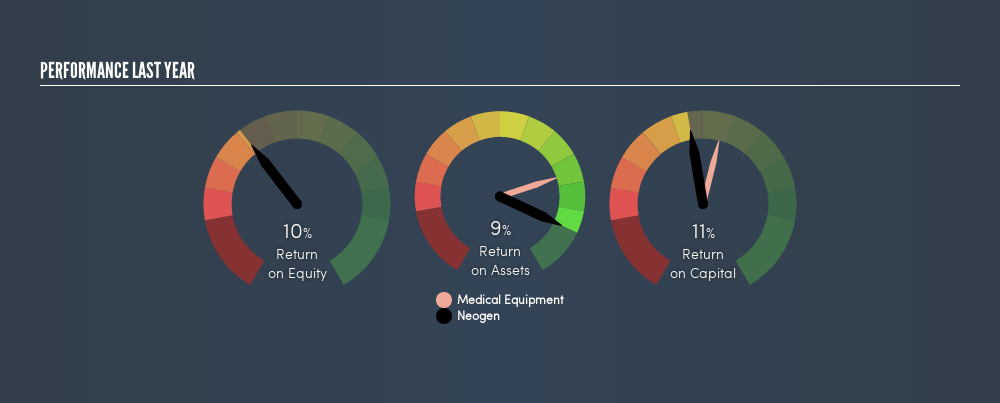- United States
- /
- Medical Equipment
- /
- NasdaqGS:NEOG
How Did Neogen Corporation's (NASDAQ:NEOG) 10.0% ROE Fare Against The Industry?

While some investors are already well versed in financial metrics (hat tip), this article is for those who would like to learn about Return On Equity (ROE) and why it is important. We'll use ROE to examine Neogen Corporation (NASDAQ:NEOG), by way of a worked example.
Over the last twelve months Neogen has recorded a ROE of 10.0%. That means that for every $1 worth of shareholders' equity, it generated $0.10 in profit.
See our latest analysis for Neogen
How Do You Calculate ROE?
The formula for return on equity is:
Return on Equity = Net Profit ÷ Shareholders' Equity
Or for Neogen:
10.0% = US$62m ÷ US$620m (Based on the trailing twelve months to February 2019.)
It's easy to understand the 'net profit' part of that equation, but 'shareholders' equity' requires further explanation. It is all the money paid into the company from shareholders, plus any earnings retained. You can calculate shareholders' equity by subtracting the company's total liabilities from its total assets.
What Does ROE Signify?
ROE measures a company's profitability against the profit it retains, and any outside investments. The 'return' is the yearly profit. A higher profit will lead to a higher ROE. So, all else being equal, a high ROE is better than a low one. Clearly, then, one can use ROE to compare different companies.
Does Neogen Have A Good Return On Equity?
One simple way to determine if a company has a good return on equity is to compare it to the average for its industry. Importantly, this is far from a perfect measure, because companies differ significantly within the same industry classification. You can see in the graphic below that Neogen has an ROE that is fairly close to the average for the Medical Equipment industry (9.7%).

That isn't amazing, but it is respectable. ROE doesn't tell us if the share price is low, but it can inform us to the nature of the business. For those looking for a bargain, other factors may be more important. If you like to buy stocks alongside management, then you might just love this freelist of companies. (Hint: insiders have been buying them).
The Importance Of Debt To Return On Equity
Most companies need money -- from somewhere -- to grow their profits. That cash can come from issuing shares, retained earnings, or debt. In the first and second cases, the ROE will reflect this use of cash for investment in the business. In the latter case, the debt used for growth will improve returns, but won't affect the total equity. In this manner the use of debt will boost ROE, even though the core economics of the business stay the same.
Combining Neogen's Debt And Its 10.0% Return On Equity
Shareholders will be pleased to learn that Neogen has not one iota of net debt! So although its ROE isn't that impressive, we shouldn't judge it harshly on that metric, because it didn't use debt. After all, when a company has a strong balance sheet, it can often find ways to invest in growth, even if it takes some time.
The Key Takeaway
Return on equity is one way we can compare the business quality of different companies. Companies that can achieve high returns on equity without too much debt are generally of good quality. If two companies have the same ROE, then I would generally prefer the one with less debt.
But when a business is high quality, the market often bids it up to a price that reflects this. It is important to consider other factors, such as future profit growth -- and how much investment is required going forward. So I think it may be worth checking this freereport on analyst forecasts for the company.
If you would prefer check out another company -- one with potentially superior financials -- then do not miss thisfree list of interesting companies, that have HIGH return on equity and low debt.
We aim to bring you long-term focused research analysis driven by fundamental data. Note that our analysis may not factor in the latest price-sensitive company announcements or qualitative material.
If you spot an error that warrants correction, please contact the editor at editorial-team@simplywallst.com. This article by Simply Wall St is general in nature. It does not constitute a recommendation to buy or sell any stock, and does not take account of your objectives, or your financial situation. Simply Wall St has no position in the stocks mentioned. Thank you for reading.
About NasdaqGS:NEOG
Neogen
Engages in the development, manufacture, and marketing of various products and services dedicated to food and animal safety worldwide.
Slightly overvalued with imperfect balance sheet.
Similar Companies
Market Insights
Community Narratives





